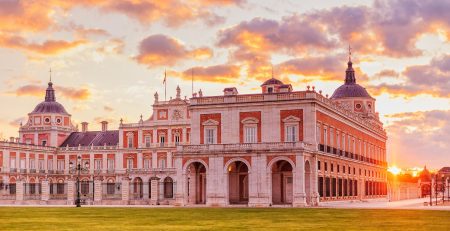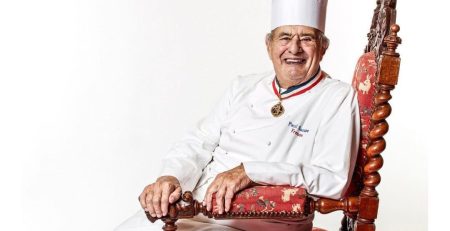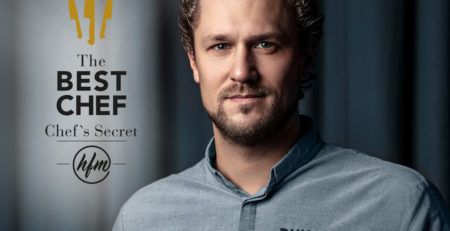At the top floor of the Smolenskaya building in Moscow’s historical centre we find The White Rabbit restaurant. The White Rabbit Family’s flagship, with a total of twenty-five Russian restaurants by restaurateur Boris Zarkov and chef Vladimir Mukhin. As you step inside the glass dome the first thing that catches your eye is the spectacular 360° view over the city. The Alice in Wonderland themed interior also stands out: luxurious and playful boasting paintings of rabbits, colourful rococo furniture and plush sofas. You truly enter a different world. Even the elevator that leads to the restaurant is decorated accordingly and oozes a distinctive aroma. Follow chef Vladimir Mukhin on social media and you’ll see him posting videos of himself singing and philosophising from this elevator.
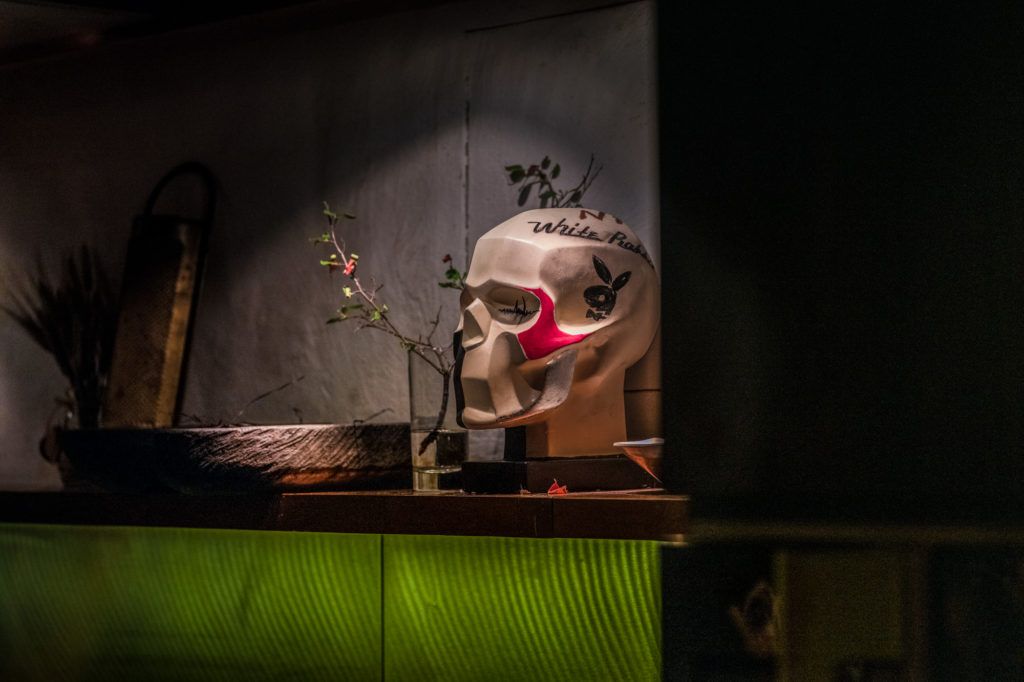
Impressive numbers
The White Rabbit is no small restaurant: 170 seats, 11 sous-chefs and 50 à la carte dishes, aside from the tasting menus. But we shouldn’t forget that we’re in a city counting more than 12 million inhabitants and in the worldwide culinary charts The White Rabbit is climbing year upon year.
In 2019 the restaurant held the 9th spot in the The Best Chef Awards.
It took but a few years for the establishment to become a true culinary hotspot.

The rabbit’s food
When we meet chef Vladimir Mukhin he enthusiastically shows us the Brassica oleracea gemmifera plant. Or, as they say, Brussels sprouts. Perhaps because we are Belgians? No. Mukhin is working on a new dish: marrowbone made from the stem of this plant. As a teaser for the new dish he hangs several plants here and there in the restaurant. It exemplifies his approach. At The White Rabbit you won’t be served heavy slabs of flesh drained in creamy sauces or need to conquer mayonnaise dressings. On the contrary. When we ask Mukhin how he’d describe the culinary style of The White Rabbit he answers: ‘not the meat of the rabbit but the rabbit’s food’. Vladimir Mukhin’s cuisine is plant-based, complemented by a fine selection of poultry, beef and plenty of seafood. Guests can choose from no less than fifty à la carte dishes and two tasting menus: ‘Contrast’ and ‘Russian Evolution’. The chef recommends Contrast which offers twelve courses and many of his signature dishes. There’s no wine arrangement for the menus but the sommelier is always on hand to help you choose from the extensive wine list (featuring many excellent Russian wines). During our tasting of the Contrast menu we relied on his expertise and were introduced to Russian Rieslings, Blanc de Noirs and a Burnier Krasnostop amongst others.
In his food lab situated in the same building of The White Rabbit restaurant Vladimir Mukhin and sous-chef Dmitri show us how the dishes are created. In the meantime, he tells us about his origins, his ambitions, his vision and ancient Russian culinary traditions.

Interview with chef Vladimir Mukhin
Chef’s Secret: How did you get started with The White Rabbit? We understand that you come from several generations of Russian chefs.
Vladimir Mukhin: The White Rabbit was not my first restaurant as a chef. Actually, I started way back in the nineties when I was eighteen, having graduated as a chef. At the time I was one of the youngest professional chefs in Russia, though I have to say it didn’t come about by accident. I was born into a family of chefs. My father and grandfather were chefs also. You can definitely say that the Mukhin family has cooking skills in its blood. I initially started out working in my father’s restaurant. Following that I moved to Moscow to work as a chef in several restaurants. But for me it wasn’t challenging enough there. Eager to learn more about European cuisine I went to France to work as a sous-chef in Christian Etienne’s restaurant. After my time in France I moved back to Moscow where I became chef in a far more modest place. When Boris Zarkov was looking for a new chef someone recommended me. Boris came over, ordered some food and made me a job offer.
That’s how I became chef of The White Rabbit.
CS: Not many people outside Russia are familiar with the culinary traditions of the country.
When did it all start?
VM: Well, the story of Russian cuisine is special and somewhat unconventional. It goes back to the times of Ivan the Terrible in the 16th century and specifically with Peter the Great during the 17th and 18th century. As you know there were close ties between French and Russian aristocracy. That influenced the way food was being cooked and served in Russia. New products were imported, meals were served in courses and the common ‘kitchen brigade’ with chef, sous-chef, commis and so on came about. Under the rule of Katharina II, the European influences increasingly evolved with the introduction of new dishes and techniques. There was also an abundance of seafood back then. You scan still come across early 19th century pictures of sturgeons of more than 4 metres long and up to 300 kilograms. All this came to an end with the Bolshevist Revolution in 1917. From then on in Russia food was looked upon as being purely functional. It had to fill the stomach and nothing more. My father recalls the time when being creative as a chef was considered to be a crime. You were stealing from the state because you added ingredients that weren’t being seen as essential. Soviet cuisine had its own culinary bible: The book of tasty and healthy food’ which I thought was ironic. Not much taste came out of it. On top of that chefs didn’t have the status enjoyed in other countries. Kitchens were tucked away in cellars, invisible from the guests. Many chefs found that convenient. That way they could dilute the food and keep some ingredients for themselves or sell them ‘under the table’.
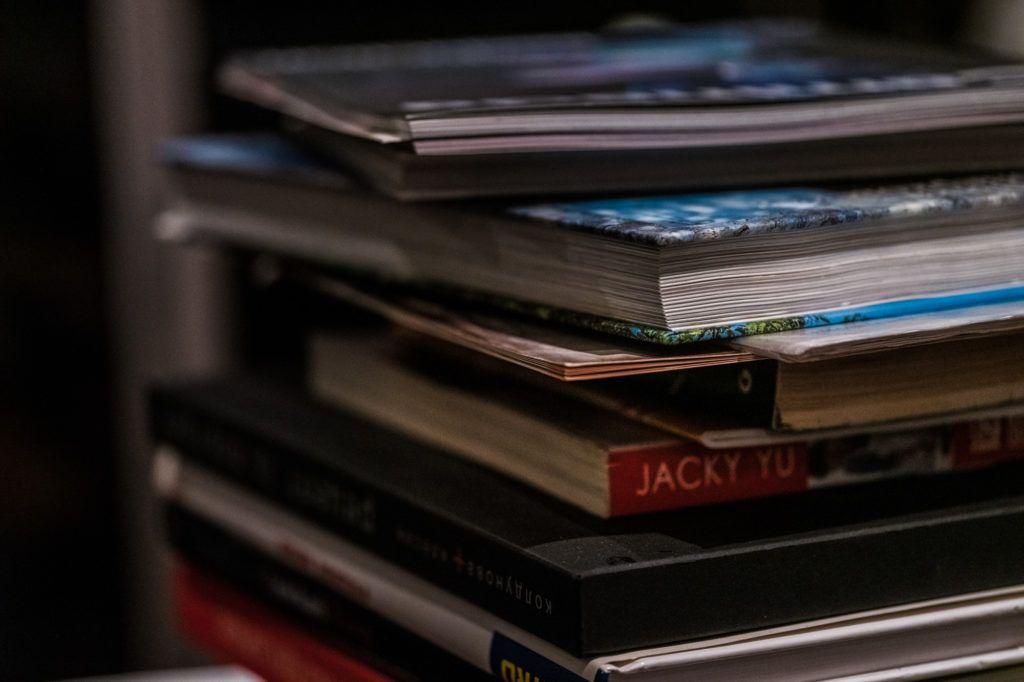
CS: And then in 1991 the old Soviet regime fell and the Russian kitchen revived.
VM: Sort of. In the beginning it was somewhat chaotic. The economic system opened up and new imported products arrived. Major brand candy bars from the West, croissants, pizzas, cocktails and sushi restaurants – though at that time not many people knew how to eat Japanese food or to even pronounce the names of the products. Gradually our gastronomy began to grow. Russians also started to travel around the world, just as I did when I went to work for French restaurants. We saw how things were being done there and came back full of ideas.
CS: But it took some time until the ‘real’ Russian cuisine came to surface.
VM: Well, there are several reasons for that. Firstly, you need to know that not many cooks were able to read or write during the first centuries when Russian cuisine started to develop under the Tsars. In reality very few classic recipes were written down and preserved. And then you had those 70 Soviet years when everything was made with tabula rasa. With ‘the book of tasty and healthy food’ as a reference you’re not going to bring over lots of people to your restaurant when they also have the option of Italian or French restaurants. For me, being a descendant of several generations of Russian chefs, it felt only natural to revive and reinvent the real Russian kitchen. And since a couple of years other Russian chefs have followed.
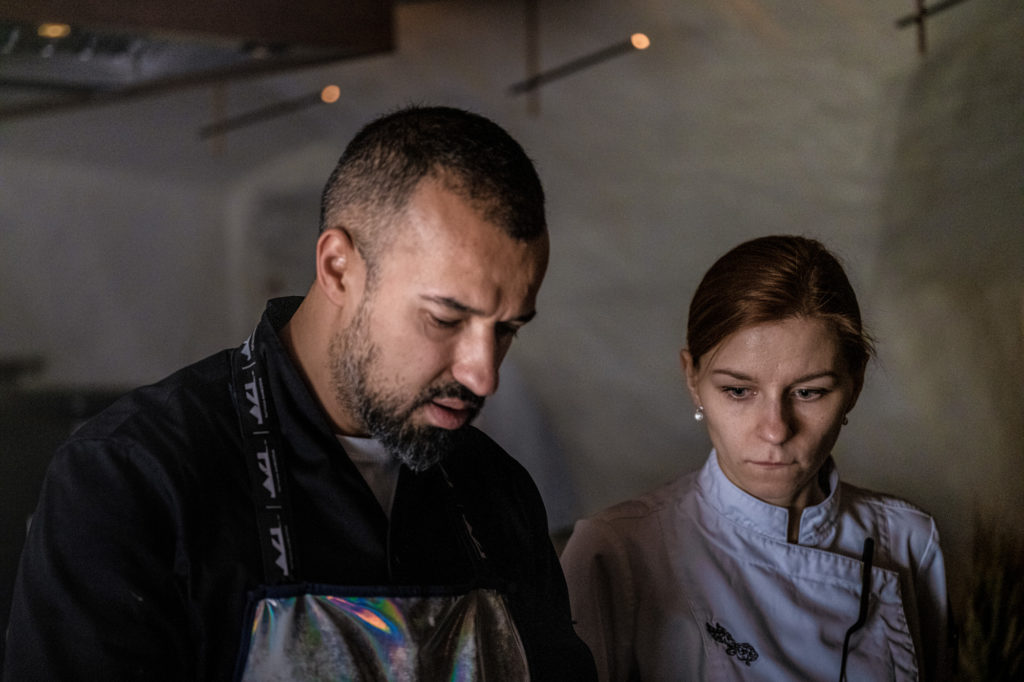
CS: With so little archive material available it must have been a gigantic task.
VM: It wasn’t easy and it still isn’t. There is so much to be discovered and rediscovered. During the Soviet times there may not have been a great culinary tradition, but my family always knew how to make the most of what was available. For example, I remember my grandmother’s borsht. She prepared it not with meat but with two different varieties of cabbage and small fish. Unfortunately, it was impossible to debone the fish, so for me as a kid eating the borsht was somewhat of a challenge. But I never forgot the taste and my grandmother’s old recipe and it inspired me for the borsht that’s currently on the menu of The White Rabbit. She also had her own type of cabbage soup with beef bone stock – we called it ‘Shee’. With fairly basic ingredients she managed to create what today we call the ‘umami’ taste. These and other informal recipes have inspired me a great deal. Today I still travel to the old villages in Russia to talk to elderly people. There are many traditional Russian dishes to be rediscovered but they aren’t being handed to you on a plate. It takes time and effort to find them. But that’s an integral part of the White Rabbit philosophy. I like to play with our traditions and add a modern twist to it. In the Contrast menu for example there is a dessert made with condensed milk and birch bast, and used to replace flour in the north of the country. With a touch of creativity, we have given the dish a modern touch. Another example of that approach is the ‘Europe vs Asia’ dish from the Contrast menu. We combine raw scallops with raspberry, guacamole and carrot voditsa, a type of juice I created starting out from a traditional recipe I found in an old book.
CS: We were also surprised by the bread served during the Contrast menu, unlike anything we tasted before. Is that also based on a recipe you discovered inland?
VM: What you are talking about is the black Borodino bread. I wanted to create my own bread for The White Rabbit. In the Holy Prilutsky monastery not far from Vologda (famous for its high level of craftsmanship) I found a totally unique variety of sourdough. The Father, who also bakes the bread for the monastery, gave me his permission and blessing to use it for The White Rabbit. Using that sourdough, we bake several varieties of bread for The White Rabbit Family. The Borodino bread accompanies the first dish of the Contrast menu. It serves as a bed for coco lardo, tender slices of coconut fruit that almost tastes like lardo. We present it together with Polugar which has some similarities with vodka but is actually a much more ancient spirit produced with rye. It offers a far richer and layered aroma than vodka and blends in excellently with the Borodino, coco lardo and linden buds that complement the dish.

CS: One of your most remarkable signature dishes, ‘Poor vs Rich’, is built around cabbage. Where did you get the idea to use cabbage, not the most noble product around, for this dish?
VM: Ah, there’s a special story attached to that dish. One day a supplier delivered cabbages to our restaurant. She was almost in tears. The cabbages had been out in the cold too long and were frozen when she delivered them. She felt sad, especially as her products are of very high quality. Throwing good ingredients away is not part of my nature, so I started to think about a way to save them. I burned some of the cabbages for a couple of hours in the Russian oven until they were totally black on the outside. When we finally tasted them, the flavour wasn’t like any other cabbage we had tasted before. I yelled to my team: ‘look at this you guys, it’s amazing!’ In the restaurant we serve the burned cabbage accompanied by a sauce consisting of three types of caviar (sturgeon, salmon and pike) and a dash of reduced champagne and scallop broth. It looks creamy but no dairy products are used. With the ‘Poor vs Rich’ dish I wanted to prove that the cheapest and most abundant products in Russia, such as cabbage, can be as tasty as the most expensive ingredients. Vegetables are definitely my favourite products to work with.
CS: You talked about the supplier that delivers the cabbages. Is it easy to source good suppliers for The White Rabbit?
VM: It’s rather difficult because we don’t have many small farmers around Moscow and the green period is short – it only lasts from May to September. And I must admit we are finicky. Only the best and most authentic products are being considered for The White Rabbit. The farmers need to be as passionate as we are. A couple of weeks ago a tomato grower visited us. He presented more than 80 varieties out of which we selected 25. These are going to be grown next year in a greenhouse exclusively reserved for The White Rabbit. We source each product from the best in their field. The quails from the ‘End of the beginning’ dish is another example. Catfish are also specially farmed for us. And so on. All-in all we have about 20 small farmers that provide us with products that qualify for The White Rabbit.

CS: Are culinary awards important for you?
VM: Yes, especially seeing the recognition comes from all over the world. When Boris Zarkov asked me to head up The White Rabbit kitchen, he expressed his ambition to get into the world’s Top 50 best restaurants. He knew I could realize this potential and gave me full trust in working towards that goal. Since then each year we’ve climbed up in the rankings with solid top 20 places over the last consecutive years. It’s great to see all the hard work paying off and that The White Rabbit’s authenticity and refinement is being recognized by an international audience.
CS: With 170 seats and 11 sous-chefs The White Rabbit is a large venture. How do you find and keep co-workers as passionate and motivated as yourself?
VM: This is something Boris Zarkov and myself closely guard. Within The White Rabbit Family there’s lots of room for initiative and self-development. Boris is a great leader with a very clear vision. The restaurants of The White Rabbit Family are not just merely about selling food. We offer our guests emotions, satisfaction and happy moments. Service is highly valued; every visit has to be a unique experience. All the restaurant chefs in the White Rabbit Family can use the food lab as also our library with our own archives and culinary literature emanating from all over the world. And proactivity is encouraged amongst the whole family, with incentives for employees who come up with original ideas to improve the White Rabbit experience even more for our guests. I myself am available as an inspirator for all the chefs of the WRF restaurants.
CS: You’ve also put your shoulders under the development and promotion of
Russian cuisine in general.
VM: Yes. Today there are many chefs in our country that want to move forward with Russian cuisine. Each year during the IKRA Talks culinary conference we come together to discuss all the aspects in our field. The IKRA platform was created by The White Rabbit Family with the goal of promoting Russian cuisine around the globe. We come together amongst peers and invite chefs from all over the world. For example, this year we welcomed Rasmus Kofoed of the Copenhagen based Geranium, Joan Roca, Enrico Crippa, Zaiu Hasegawa from Den in Tokyo and Matt Orlando from Amass. Year after year enthusiasm grows, with more chefs and restaurant professionals joining in and launching new ideas. It can only benefit the further development of our cuisine and the establishment of Russia as a culinary destination.

CONTRAST MENU

FLORA – FAUNA
Sunflower and smoked caviar

SEA – LAND
Sea urchin caviar, potatoes, tangerines and sea water
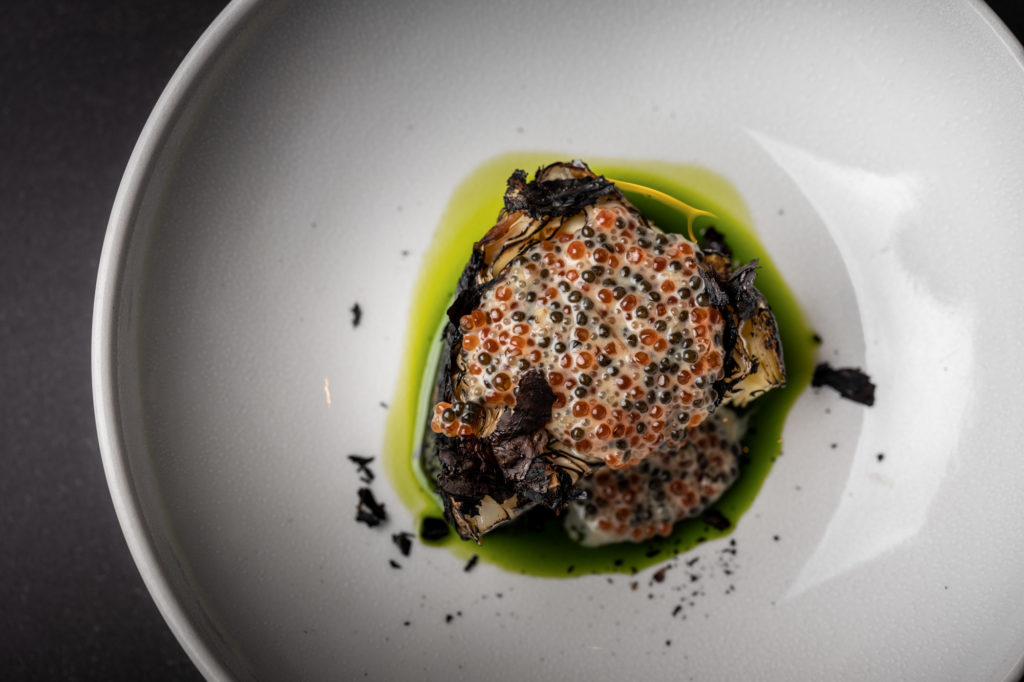
POOR – RICH
Cabbage, caviar and champagne

END – BEGINNING
Quail, egg and corn

BEGINNING – END
Lettuce, avocado and onion

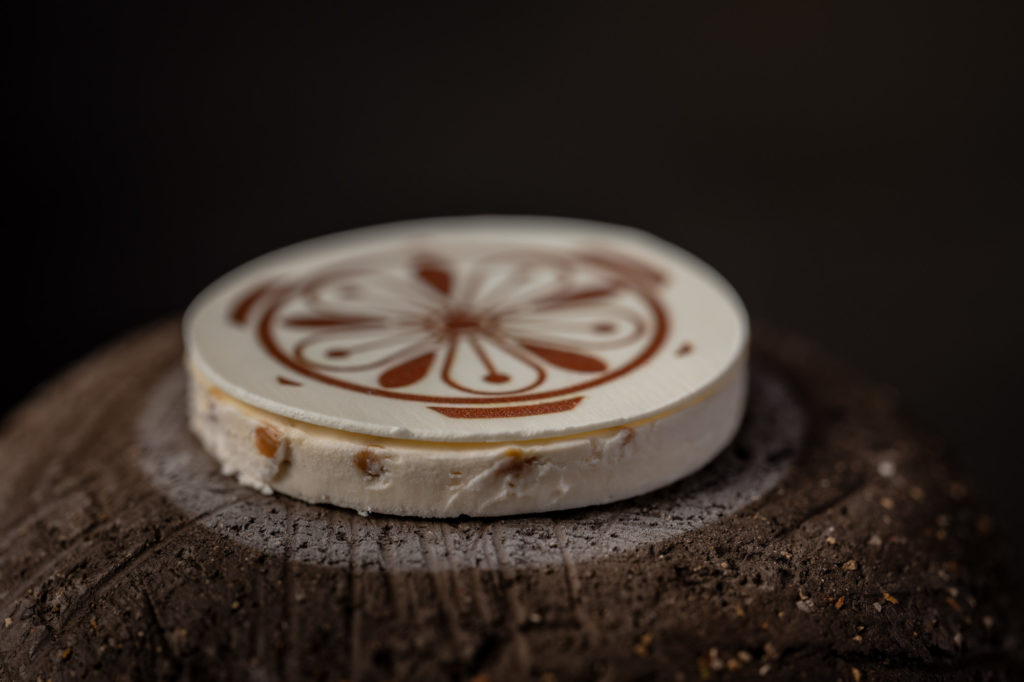
PAST – FUTURE
Birch bast and condensed milk

BORODINO BREAD
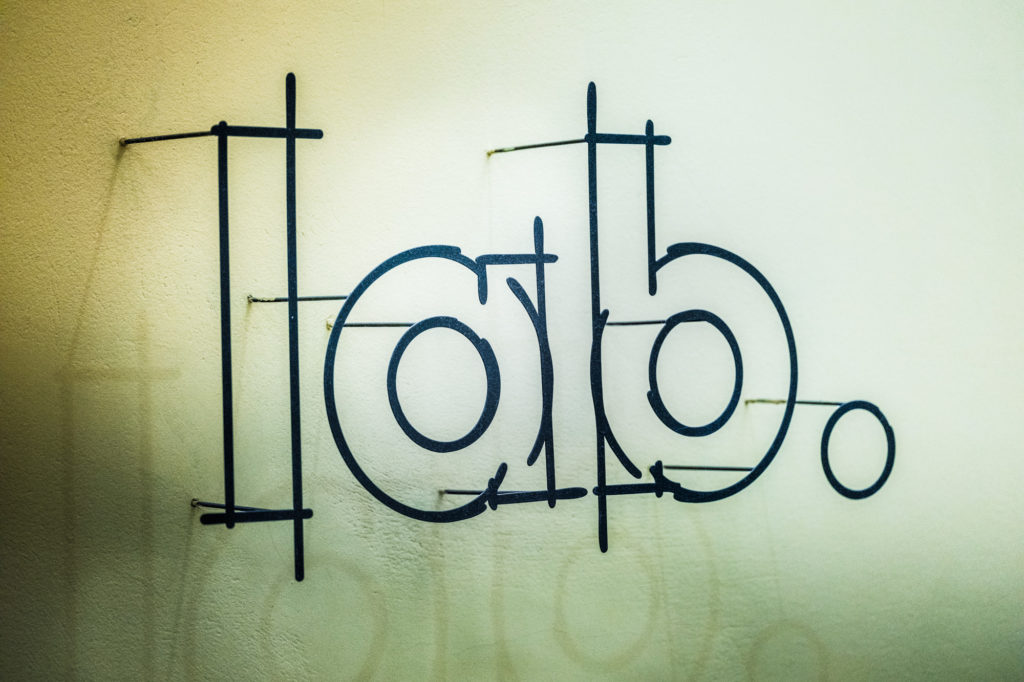
TEAM

Practical information
White Rabbit Restaurant & Bar, Smolenskaya Square, 3, Moscow, Russia, 121099
+7 495 510-51-01 | https://whiterabbitmoscow.ru/en/ | White Rabbit Facebook
| White Rabbit Instagram
–
Text: Wim Provoost
Photography: Adriaan Van Looy



